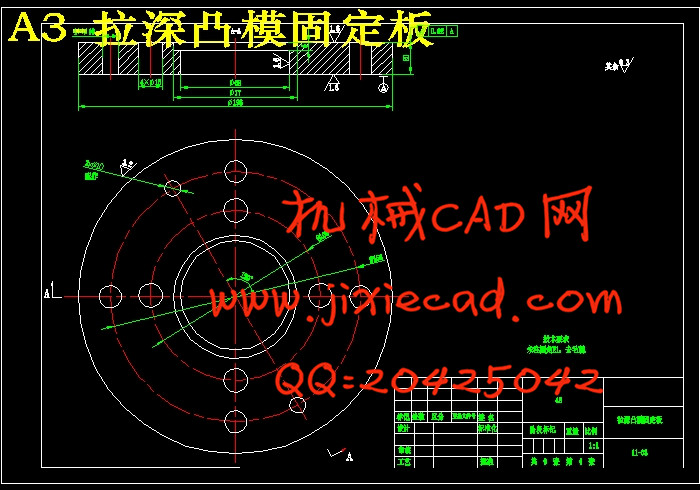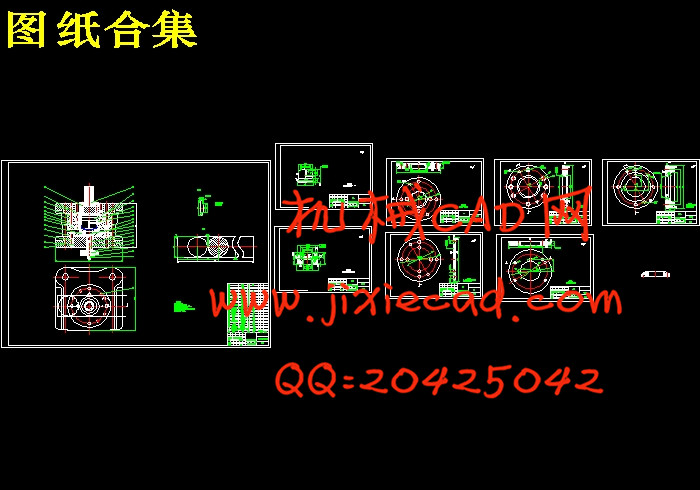设计简介
端盖冲压成形工艺与模具设计
摘 要:本设计为一端盖的冲压模具设计,我参考了大量有关拉深模模具设计实例等方面的资料。拉深是利用拉深模将板料制成各种空心件的一种方法,是冲压生产中应用最主要的工序之一。根据设计零件的尺寸、材料、批量生产等要求,首先分析零件的工艺性,确定冲裁工艺方案及模具结构方案,然后通过工艺设计计算,确定排样和裁板,计算冲压力和压力中心,初选压力机,计算凸、凹模刃口尺寸和公差,最后设计选用零、部件,对压力机进行校核,绘制模具总装草图,以及对模具主要零件的加工工艺规程进行编制。其中在结构设计中,主要对凸模、凹模、凸凹模、定位零件、卸料与出件装置、模架、冲压设备、紧固件等进行了设计,对于部分零部件选用的是标准件,就没深入设计,并且在结构设计的同时,对部分零部件进行了加工工艺分析,最终才完成这篇毕业设计。
关键词:模具,落料,拉深,凸模,凹模,凸凹模
BEARING CAP PARTS TAMPING
FORMING THCHNOLOGY AND
DIE DESIGN
ABSTRACT: The design for a plate of bearing cap die design, In this design, I made reference to the large number of Die mold design example. The drawing is a drawing die as a processing method of the sheet metal stamping into a variety of hollow, is the most widely used in the stamping process.According to the size of the design components, materials, mass production, etc., the first part of the process of analysis to determine the blanking process planning and die structure of the program, and then through the process design calculations, determine the nesting and cutting board, calculate the pressure and pressure washed centers, primary presses, computing convex and concave Die Cutting Edge dimensions and tolerances, the final design selection of parts and components, to press for checking, drawing die assembly drawings, as well as Mold processing technology of the main parts to the preparation procedures. In which the structural design, primarily to the punch and die, punch and die, positioning parts, unloading and out of pieces of equipment, mold, pressing equipment, fasteners, etc. has been designed, for the selection of some components are standard parts , there is no in-depth design, and structural design, while some parts for the processing process analysis and ultimately to complete this graduation project.
KEY WORDS: mold ,blanking ,deep drawing ,punch ,die ,punch and die
目 录
1 绪论 1
1.1冲压模具在工业生产中的地位 2
1.2冲压技术的现状及发展方向 2
1.3冲压模具的分类 6
2 落料拉深复合模 8
2.1冲压件的工艺分析 8
2.1.1制件的结构分析 8
2.1.2冲裁件断面质量 9
2.1.3制件的尺寸精度 9
2.2工艺方案及模具结构类型 9
2.2.1工艺方案分析 9
2.2.2主要工艺参数的计算 10
2.3确定排样图和裁板方案 11
2.3.搭边的选取 13
2.3.2送料步距、条料宽度及板料间距计算 14
2.4计算工序冲压力、压力中心以及初选压力机 14
2.4.1模具类型的选择 14
2.4.2冲压力的计算 15
2.4.3压力中心的计算 16
2.4.4压力机的初选择 17
2.5模具工作零部件刃口尺寸的计算 17
2.5.1落料模刃口尺寸的计算 18
2.5.2拉深模工作部分尺寸的计算 18
2.5.3拉深间隙的计算 19
2.5.4拉深凸、凹模圆角半径的计算 19
2.6模具主要零部件的设计 19
2.6.1工作零部件的结构设计 19
2.6.1.1落料凹模的结构设计 19
2.6.1.2拉深凸模的结构设计 21
2.6.1.3凸凹模的结构设计 22
2.6.1.4压边圈设计 23
2.6.2定位方式的选择及标准化 23
2.6.2.1挡料销的选择及标准化 23
2.6.2.2导料销的选择及标准化 24
2.6.3卸料装置的选择及标准化 24
2.6.3.1弹性卸料板的结构形式 24
2.6.2.2卸料螺钉的选用 25
2.6.3.3弹簧的选用 25
2.6.4推件、顶件装置的选择及标准化 26
2.6.5支撑固定零件的设计及标准化 26
2.6.5.1模架的选用 26
2.6.5.2凸凹模固定板 27
2.6.5.3拉深凸模固定板的设计 27
2.6.5.4垫板的设计 28
2.6.6导向零件的设计与标准化 29
2.6.7紧固件的设计与标准化 30
2.7压力机的初选及校核 30
2.7.1压力机的选择 30
2.7.2装模高度的校核 30
2.8凹模强度的校核 31
2.9模具总装图和工作原理 32
2.9.1模具总装图 32
2.9.2工作原理 32
3 总结 34
致谢 36
参考文献 37











